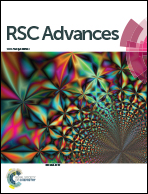Synthesis, structure and luminescent properties of a new blue-green-emitting garnet phosphor Ca2LuScZrAl2GeO12:Ce3+†
Abstract
A series of new garnet phosphors, Ca2Lu1−xZrScAl2GeO12:xCe3+ (0.005 ≤ x ≤ 0.1), have been successfully synthesized through a conventional high-temperature solid-state reaction method. The crystal structure and electronic structure of the host, and the morphology, luminescence property, diffuse reflectance spectra, fluorescence lifetime and thermal stability of the phosphors are investigated in this article. The crystal structure was characterized by X-ray diffraction Rietveld refinement and it belongs to the Ia![[3 with combining macron]](https://www.rsc.org/images/entities/char_0033_0304.gif) d(230) space-group. The band gap of this matrix is about 5.15 eV, which is much narrower than that of YAG, enhancing the possibility of photo-ionization. The optimized phosphor can be excited by UV or near-UV light in the range of 320–420 nm and exhibits a broad blue-green emission centering at 472 nm under 405 nm excitation. In addition, the concentration quenching mechanism and differentiation of dodecahedral sites were discussed in detail.
d(230) space-group. The band gap of this matrix is about 5.15 eV, which is much narrower than that of YAG, enhancing the possibility of photo-ionization. The optimized phosphor can be excited by UV or near-UV light in the range of 320–420 nm and exhibits a broad blue-green emission centering at 472 nm under 405 nm excitation. In addition, the concentration quenching mechanism and differentiation of dodecahedral sites were discussed in detail.


 Please wait while we load your content...
Please wait while we load your content...